Grace Jones: 'Sometimes you have to be a high-flyin' bitch'
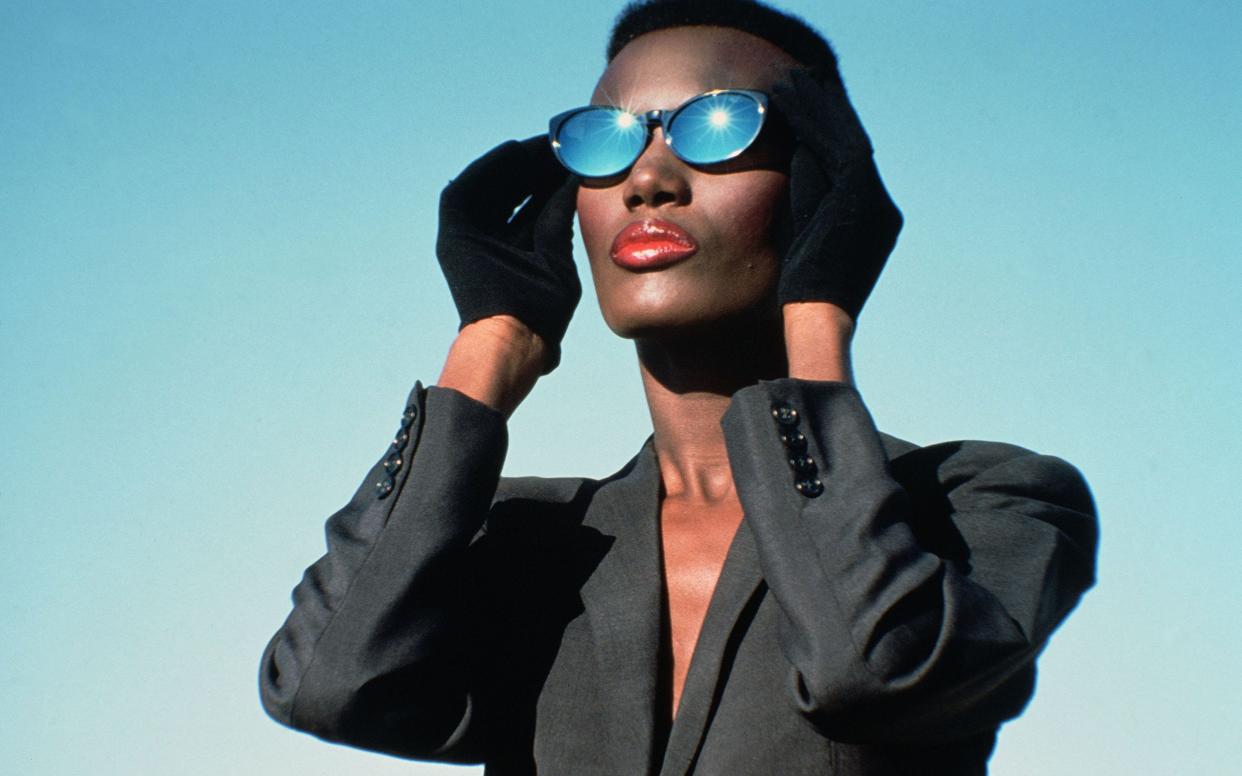
Aged 69 (probably), Grace Jones still loves to perform naked, requires Cristal champagne and oysters before she'll go on stage and proudly proclaims herself a 'high-flyin' bitch'. Jessamy Calkin gets a behind-the-scenes glimpse of a diva on a roll
At the Wilderness festival in Cornbury Park in Oxfordshire, a large box of oysters is being ferried to the Portakabin that serves as Grace Jones’s dressing room. Six bottles of Cristal are already lined up on ice in there, along with some good vintage red wine and a few bottles of very expensive white. This is Grace Jones’s standard rider.
There is a flurry of activity; her band are there (including her son, Paulo), along with her friend the actor Sarah Douglas, her brother Chris, her manager Brendan, her wardrobe head and two assistants juggling Philip Treacy hats, plus Marjorie Grant, who manages her business affairs. And Sophie Fiennes, who has made a film about her.
Jones oozes out of her trailer and leers at us all. She is wearing – well, nothing, really. Nothing substantial. A lot of white war paint (she looks like one of Don McCullin’s tribal photographs), a corset that covers a bit of her midriff, a veil and a golden skull mask, and some fairly ridiculous shoes, one of which gets stuck as she’s climbing up the wooden steps to the stage.
Even in this outfit she has an astonishing amount of elegance and gravitas. She takes one look at the stage and comes back down again. ‘I’m not going on! There’s no wine!’ She stomps down the stairs. ‘Brendan?’ she shouts to her manager. ‘Are you nervous?’ She cackles – she has a fabulous laugh – and everyone relaxes.
She does perform, of course. Boy, does she perform. All her hits – La Vie en Rose, Warm Leatherette, Love Is the Drug – with a different elaborate costume for each song – giant net skirt, bustles, wigs, a breathtaking variety of hats (‘It’s a church thing!’) – changing at the back of the stage, chatting to the audience all the while through her microphone.

There’s a Valkyrie helmet and long white wig, in which she is paraded through the crowd on the shoulders of an obliging security man, and for My Jamaican Guy she comes on in a winning trilby and dildo combination, a black shawl barely covering her breasts, and dances on a podium overlooking the stage.
A muscular acrobat called Nico Modestine enhances things with a spectacular display of pole dancing. The famous hoop comes out for Slave to the Rhythm and Jones introduces her band while doing a long, slow hula hoop. It’s almost shamanic. The band are grinning and the audience crackles with excitement.
‘I’m having the best party!’ whoops Jones. ‘Damn it! I FEEL that love.’
Grace Jones is 69. Or thereabouts. She loves all the confusion around her age and is hazy on these things but the general consensus is that she was born in 1948. She looks incredible. Her body is still athletic and slim and powerful-looking. Her face is unlined – wider, but not fatter, than in her youth.
Grace Jones | The star's dressing room shall always be equipped with
Her fear of needles has exempted her from having any plastic surgery (and heroin addiction, possibly). It is genetic, she says. Her mother (who died two weeks ago, at the age of 88) had ‘skin like a baby’s butt’.
‘I’m in time,’ says Jones. ‘I don’t think about getting older. People look older because they’re so busy thinking about it.’ She has not slowed down. ‘I just take my time.’
Nor does she seem like a person who has mellowed with age. ‘Of course I’m mellow! I’m not beating people up like I used to. I’ve just figured out that the consequences are not worth it. Sure, I’d like to box a few people around when they get in my face, but I’ve got wiser now. I use intelligence more and di-plo-macy…’ she picks at the word. ‘I was not a diplomat, but now I have more patience.’
Here she is possibly referring to the famous Russell Harty incident of 1981, when the chat-show host first patronised her, and then turned his back on her during his television show. She slapped him and hit him repeatedly. It became a defining moment in both their careers.

The connection between Sophie Fiennes and Grace Jones was forged during a dinner at L’Etoile restaurant in London, in the spring of 2002. Fiennes had just screened her new film, a documentary called Hoover Street Revival about Bishop Noel Jones, Grace’s brother, and his church community in South Central LA. When the screening finished, Jones – whom Fiennes had never met – was on her feet whooping and clapping.
‘I love the smell of your film…’ she called across the screening room in her distinctive throaty drawl.
Later, she plied Fiennes with questions about filming Noel’s world. Her own experiences growing up with the church had been bitter. ‘Honey,’ she said to Fiennes. ‘I am church-burnt! To a cinder. To a crrrrissppp!’
‘It was classic Grace,’ says Fiennes, ‘She’s brilliant with language – when she’s doing vocals in the studio, it’s a bit like Noel’s preaching – language is like clay to her; she plays with it.’
Of course I’m mellow! I’m not beating people up like I used to. I’ve just figured out that the consequences are not worth it
Fiennes – a confirmed atheist – told Jones about an experience she’d had while filming in Noel’s church. It was Mother’s Day. Fiennes’ mother Jini (the artist and novelist Jennifer Lash) had died of cancer several years earlier, leaving behind a husband and seven children, when Fiennes was 26.
Bishop Noel Jones was preaching about Mother’s Day ‘and I suddenly felt the spirit of my mother’, says Fiennes. ‘I was feeling her loss, the loss of contact with her children, the loss of motherhood, I felt like she came into my body and I experienced her grief. It was as if she was inside me, animating me. And I suddenly had this outburst of crying and sobbing, and someone asked, are you OK? And I said, I’m fine, I’m crying my mother’s tears. These are my mother’s tears, they’re not mine.’
Fiennes told Jones her story, and Jones exclaimed, ‘Oh my God, I love that!’ And she wrote a song called I’m Crying (Mother’s Tears) which is on the Hurricane album. ‘We connected through that potential in church for these really quite wild things to happen.’
‘The first time we met, it was like we were sisters in another life,’ Jones tells me. ‘It was like two gypsies really. I was very comfortable with her.’

She also liked the fact that Fiennes, too, came from a big family (her five brothers include the actors Ralph and Joseph). They decided to work on a film together, but it was uncertain what that would be. Jones loves to collaborate and Fiennes made a decision to freewheel – she thought, I’ll just shoot and shoot until I’ve got enough material.
She became part of Jones’s team, taking off at short notice to record what she was doing; she kept a bag packed in the hall, as if for childbirth. ‘Grace would call and say, “Hey, I’m going to Moscow, do you want to come?” or, “Come to Barcelona!”’ And off she would go – to Paris for a corporate gig, to Jamaica for a Jones family reunion, to the recording studio, to the spa.
She filmed Jones live on stage in a lavish variety of costumes, Jones eating coconuts in Jamaica, berating musician Robbie Shakespeare on an ancient mobile phone, Jones struggling to open oysters (‘They’ve got some tight muscles; I wish my pussy was this tight’). Jones in tears watching her mother sing in church, Jones swimming in the middle of a lagoon, talking in her repertoire of accents – Jamaican patois to a local old man (‘Wicked hat, man. You have blue circles around your eye, like me Daddy’) – and posh British, or fluent French in a Parisian taxi.
We see Jones in the shower and Jones having a champagne breakfast. We hear Jones’s philosophical musings (‘All men need to be penetrated just once in their life, because then they’ll know what it’s like to receive!’) Jones bawling out her hapless ex-manager and refusing to go on stage until her presidential suite in Tokyo has been paid for (‘Sometimes you have to be a high-flying bitch!’).
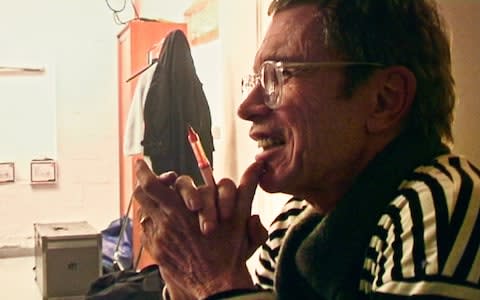
Jones with her son, her siblings, her neighbour Miss Myrtle, and her former lover Jean-Paul Goude. Jones in an otherworldly range of hats (Philip Treacy’s name is the first credit of the film) – and Jones in nothing at all. (She loves to be naked. She once went to a party wearing only a necklace made of teeth.)
Fiennes started shooting in 2005. She shot the final sections in 2016: 11 years. The film had a life of its own. Because initially they were financing it themselves, there was no pressure. In-between, Fiennes had a son, Horace, now seven, and made four other films; Jones wrote a book, recorded an album, toured and appeared live countless times, got through several boyfriends and became a grandmother.
She trusted Fiennes entirely but bureaucracy is a kind of authority and Jones does not like to be subjugated to it. In December 2015, after some months of Fiennes trying to pin her down, she finally signed the agreement. She had no creative control (‘she had full and meaningful consultation,’ says Fiennes) nor did she want to change a thing, apart from a few subtle tweaks to do with ‘rhythmic calibrations’.
Were there any restrictions on what Fiennes could film? ‘None,’ she says. ‘She never said, “Put the camera away.” Never. In fact, she said things like, “There’s this great water massage at Strawberry Hill – you should film me having that…”’ The only time Jones got angry with her, says Fiennes, was once when she’d stopped filming.
‘I was on my knees with tiredness, I’d been up most of the night with her family, and she said, “Get up! You should be filming me shopping at Issey Miyake!”’
And so the editing began – Fiennes had 310 hours of film to sort through (she chose film rather than digital because, she says, 'in the words of David Lynch, "something cosmic happens when you push light through film"'). The result is Bloodlight and Bami (a type of Jamaican bread) – a spectacular and dreamy film made up of moments, not a biopic or a conventional documentary with a narrator and talking heads. ‘It’s not fiction but it’s not journalism either,’ says Fiennes. ‘It’s the richness of time and moment captured. In the edit I discovered I could play all kinds of games, moving between day and night and from place to place with Grace.’
We are in Fiennes’s flat in south London and she is composing an email to the film’s publicists for the following week’s Toronto Film Festival, who have ill-advisedly arranged press interviews with Jones for 2pm. Grace Jones will be asleep at 2pm. She does not leave her bed before 4pm, most days.
In all the years that Fiennes has known her, she says, she only once remembers Jones getting up before noon. ‘We were going to Wimbledon to see Serena Williams play.’ (Jones loves tennis.) ‘Brendan Coyle, Grace’s music manager, urgently advises…’ types Fiennes, reading aloud, then she pauses, ‘as I’ve said all along… that a start time of 2pm is not going to work…’ She starts again.
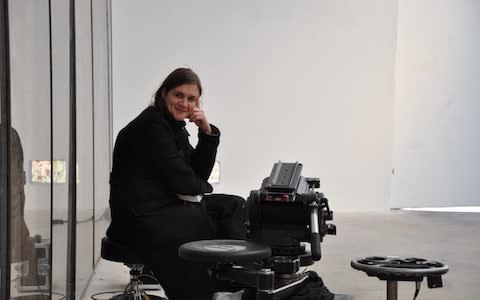
‘Brendan is adamant a 2pm start is not going to work…’ (Fiennes laughs. She has dimples.) ‘Brendan insists we should start the conference at 6pm, and if the journalists are not up for that then we will have to let these interviews go…’ She presses ‘send’ and shuts the laptop. ‘… And tough shit for them.’
If Fiennes had her way, a press conference would begin at 10pm. ‘Or midnight. They think I’m pandering to Grace’s diva-ishness, but I’m not. Midnight for Grace is early evening.’ In the event, the interviews start at 6.45pm. The Toronto audience goes wild and receives the film in the spirit it is intended. Jones is not a diva.
‘I’m a vampire,’ she tells me later. Going to bed at dawn is in the family. Even when she was growing up in Spanish Town, Jamaica, there were a lot of late nights. ‘There would be church, and then sewing – my mum was a top seamstress and we’d be sewing patterns from Yves Saint Laurent or Givenchy. And church was a kind of party – people would come over and we’d all stay up late.’
Grace Jones
She’s never worn a watch, but, she says, she can tell you what the time is to within two minutes.
Grace Jones grew up in a strict Pentecostal church background. Her parents, Marjorie Williams and father Robert Winston Jones, moved to America to work when Grace was five, and she and four of her siblings were left in the care of her grandmother, and her step-grandfather, Master Peart (Mas P).
It was an oppressive childhood – church, discipline and regular beatings at the hands of Mas P, an experience that has informed a large part of her life. She has inherited traits from both her mother and her father’s family. Her maternal grandfather played with Nat King Cole, and her mother had an amazing soprano voice.
‘There’s this musical bloodline I can feel flowing through my family,’ says Jones, who recorded a song called Williams’ Blood. ‘Williams is wild – I don’t care, I’m just having a good time.’ The Jones’s blood is conservative, academic: they really do church (her father was a bishop), and they are judges in civil society in Jamaica.
‘Her mother was always worried about her Williams blood,’ says Fiennes. ‘She’d say, “Why can’t you be a Jones? The Jones’s are upstanding and move through the world in a proper way.” ‘But she’s clearly a Jones, too. In the film, her mother says, “A Jones never comes second – they always come first. And Grace has that sense of entitlement of being a Jones. When people say, “You’re such a diva,” she says: “No, I’m a Jones!” That’s the Jones/Williams schism.’
Despite the church scourge that blighted her childhood, Jones still goes to her brother Noel’s (more tolerant, philosophical) church in LA. ‘His church is completely different. There’s no dress code – you can come in butt-naked and people just move over for you to sit down.’
When she was 13, she and her siblings moved to Syracuse, New York, to be with her parents. She went to college, did some acting and a bit of modelling with an agency called Wilhelmina Models. But Grace was a rebel. She had an Afro, then shaved her head, and she generally didn’t fit in with the accepted view of how black models should behave, or the endemic racism that was prevalent in the industry then. In 1966 she moved to Paris.
Grace Jones loves to be naked. She once went to a party wearing only a necklace made of teeth
At that time her look was her own – she was a tall skinny black girl with hardly any hair wearing army surplus gear. She did her own make-up and, ‘The short hair was my look and Paris loved it,’ she says in her book I’ll Never Write My Memoirs. ‘I looked natural and unnatural at the same time.’
The book, written with Paul Morley, is a hoot. It contains such sentient lines as, ‘The first thing I did when I was pregnant was to give up Quaaludes,’ and, ‘Trevor called just as I was setting fire to Dolph Lundgren’s trousers…’ and reveals that she loves jigsaw puzzles and sometimes stays up all night doing them.
In Paris, she learnt French in three months flat. And misbehaved. If she didn’t get butter with her bread she threw the baguette at the waiter, and she would carry around eggs to lob at taxi drivers who wouldn’t stop for her. She joined the influential agency of Johnny Casablancas, who made the mistake of telling her, ‘Well, to be honest, selling a black model in Paris is like trying to sell them an old car nobody wants to buy.’
It motivated her, she says, like nothing ever had before. ‘Until that moment I’d never in any way felt inferior because I was black.’ She screamed at him that she would make him eat his words, ending with, ‘And I hope you die of cirrhosis of the liver!’
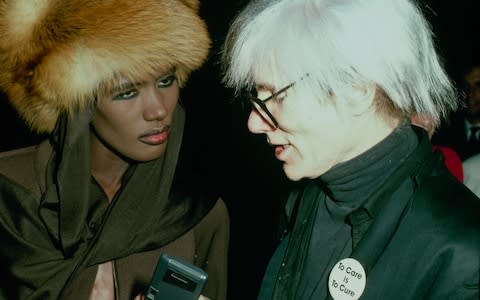
She then joined an agency called Euro Planning, along with its other two top models of the time, Jerry Hall and Jessica Lange. Designers loved them and were influenced by how they dressed, which made them feel less powerless. She got taken up by photographers like Helmut Newton and Hans Feurer; her first Vogue cover (in 1975) was a Hans Feurer close-up of her mouth.
Jones loved to sing. She would always sing while getting ready to go out. The first time she performed in public was in New York, at a small club on West 22nd Street. She did three songs and wore Issey Miyake, a love affair with whose clothes continues to this day. She hung out a lot with Keith Haring and Andy Warhol, who she thought was great – he liked to tape her, she liked to perform. These were the days of Studio 54.
‘It appealed to my sense of outrage,’ she writes. ‘I would go all dressed up and come home with my designer clothes in tatters from all the activity and movement. Going out was a very physical thing.’ In the early ’80s she made a few films, most notably playing May Day opposite Roger Moore in A View To a Kill, but music was her true love.
It was Chris Blackwell, the Island Records founder and perhaps greatest exporter of Jamaican music over the last century, who was crucial in establishing the Grace Jones sound. ‘Chris took all my different worlds and stuck them together to create The Compass Point All Stars,’ she writes. ‘The erotic French side, the acid-tripping rock and roller, the Jamaican drum and bass, the androgynous, android electronics – it was magical, this assembly of pieces that fitted together.’
Blackwell is her ‘good father’; she adores him and sees him whenever she is in Jamaica. She signed with Island in 1977 but it was her fifth studio album, Nightclubbing, with its iconic Jean-Paul Goude cover, that established her as a monumental success.
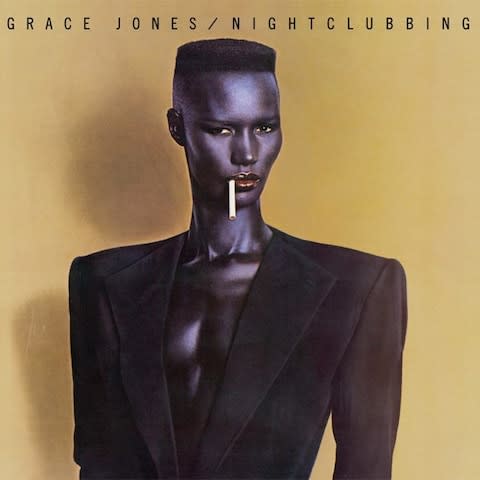
There have been five more studio albums since. Goude, an illustrator and artist, and father of her son Paulo, was the love of her life. He was, she reveals in the film, the only person who made her ‘buckle at the knees’. But both initially had reservations about the other – her music wasn’t to his taste, he said, and at first she didn’t find him physically attractive. Intellectually, though, their relationship soared.
She became his muse, as he created her iconic covers for Slave to the Rhythm and Island Life, and directed A One Man Show – her stage show and the subsequent film of it. But eventually, she became concerned ‘that he preferred the illusion he’d created, not the actual me’.
She felt a pressure to be perfect; he didn’t want to watch her give birth, worried that he then wouldn’t want to have sex with her (that old chestnut). In the end, she says, ‘I was so scared of looking less than perfect that I would pose even on the toilet.’
They split up around 1982, though remain close friends today. Goude was followed by the actor Dolph Lundgren, then called Hans, who she met when he was on security outside her dressing room as a part-time job. Since then she’s had quite a few boyfriends – and one short-lived husband, a Turk called Atila Altaunbay. (She says she doesn’t believe in divorce, and she can’t find him anyway.)

In 2006 she met Ivor Guest (record producer, composer, Viscount) and they became what Jones described as ‘passionate friends’. It was a difficult time in music and Jones had become disillusioned with the record companies and demands put on her. Guest went on to produce her album Hurricane, released 19 years after her previous one.
‘I asked her why she hadn’t recorded for so long and suggested we make a record – “I’ll produce it, you pay for it and we’ll just do it without any labels involved,”’ says Guest. ‘And that’s what we did. It was a much harder road than I thought it would be, but it was smart of her to not do anything for 19 years because that made it possible for me to re-contextualise the music.
In Paris she would carry around eggs to lob at taxi drivers who wouldn’t stop for her
It’s a very exciting thing on an artistic level to work with Grace – she’s not phased by anything you throw at her; in fact, she wants you to go further. She’s like an earthquake; a fountain of uncontrolled creativity.’ It took a year to get it released but Hurricane went on to be really successful. They are now working on another album.
‘What’s fun about working with Grace is that it’s like a massive art project,’ says Guest. ‘Her persona is almost like an avatar that you can take to different aesthetic environments and we had the idea that Africa would be the place to go with this new project.’
So that’s her plan now. To finish the album. And more shows. ‘I can never imagine not performing,’ she tells me on the phone from Jamaica. ‘Though I don’t work so much in America any more – they don’t have, let us say, the same respect for my prices as they do in Europe. And if I get tired of travelling, I’ll just build my own theatre. I’ll perform there and everybody can come: we can have the Grace Jones Festival.’

She is more a performance artist than a singer, in the true sense of the term. Does her sense of identity depend on performing? ‘No, but it’s my freedom of expression,’ she says. ‘My freedom of letting stuff out. It’s my party. And my band’s party.’ She earns her money from touring, and from performing at corporate gigs and private parties, but she won’t do television shows like X Factor, and she has been offered millions to appear on Celebrity Big Brother. ‘I wouldn’t do it for 100 million dollars. I wouldn’t do it for a billion – it’s the one part of me you can’t buy.’
She has apartments in Jamaica and New York, and she rents a flat in London. But she is sick of travelling. Even first class. ‘It’s not as glamorous as it used to be. It’s really taxing. And when you get searched – they’ll be interviewing me when they’re patting me down – and wanting a selfie! It’s unbelievable. It’s weirrrddd,’ she drawls. ‘And people think I’m freaky!’
Does she agree to the selfies? ‘Hell, no! I tell them right off: Get that thing out of my face! You’re not a photographer! And your arms are too short! That’s what I tell them!’ she cackles.
I’m glad to hear you haven’t lost your disrespect for authority, I say. ‘The authority thing? I don’t have to deal with authority any more. I’m in charge now.’
Grace Jones & Friends Live will be in cinemas nationwide for one night only on 25 October, and Grace Jones: Bloodlight and Bami will be released in cinemas on 27 October; gracejonestickets.co.uk